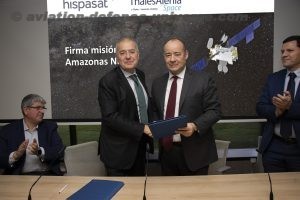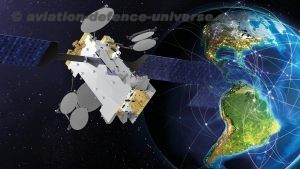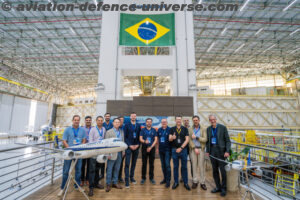- The Spanish operator kicks off its new mission Amazonas Nexus, devoted to the mobility and connectivity markets, marking the start of a new generation of satellites with an innovative architecture and higher capacity.
- The new satellite, embarks a new generation Digital Transparent Processor (DTP), a technological breakthrough that substantially increases the flexibility of the satellite, allowing its adaptation to eventual changes in the customer’s demand.
- Amazonas Nexus, which will have an important participation of the Spanish aerospace industry, is scheduled for launch at the end of 2022 and has an expected lifetime of 15 years.
- 7th satellite based on Thales Alenia Space Spacebus NEO platform (KONNECT, SES 17, SYRACUSE IV, KONNECT VHTS, SATRIA, EUTELSAT 10B, AMAZONAS NEXUS)

Madrid, January 10, 2020 – HISPASAT, the Spanish satellite telecommunications operator, has awarded to Thales Alenia Space, a joint venture between Thales (67%) and Leonardo (33%), the construction of the Amazonas Nexus satellite, which will replace and expand the capacities of Amazonas 2 satellite, in orbit at 61º West. The contract has been signed today in Madrid, with Thales Alenia Space winning the award against an international field of competitors.

The new High Throughput Satellite (HTS) will enable HISPASAT to access new customers and markets, by delivering high capacity mobility services to the air and maritime transport sectors, among others. In addition, it will continue the provision of services to the current HISPASAT customers that use the capacities of Amazonas 2. As prime contractor, Thales Alenia Space will be responsible for Amazonas Nexus satellite design, production, testing and in-orbit acceptance tests.
New generation with greater in-orbit flexibility
Amazonas Nexus features, as main novelty, a new generation Digital Transparent Processor (DTP), a technological breakthrough that is essential to increase the geographical flexibility of the mission to respond to eventual evolutions with respect to the initially envisaged commercial scenario.
Thanks to this element, the satellite payload will be digitally processed allowing to assign in-orbit the required capacities at any time, providing the satellite with great resilience to the evolution of the communications market, both in the field of connectivity and data and in the field of contents transmission.
The advanced design, HTS capacity and versatility of Amazonas Nexus make it the most efficient satellite in HISPASAT’s fleet. The new satellite will have coverage over the whole American continent, the North Atlantic corridor (air and maritime traffic area) and Greenland, and will enable the provision of leading-edge telecommunication services in Ku band. Amazonas Nexus marks the start of a new generation of satellites in HISPASAT’s fleet with an innovative architecture that also features Ka-band capacity to optimize communications between the gateways and the satellite, allowing to multiply the total on-board capacity available for commercial use, thus improving to a great extent the capacity unitary cost with respect to conventional satellites.
Amazonas Nexus will be launched in the second half of 2022
Based on the Spacebus NEO platform from Thales Alenia Space, the satellite will feature full electric propulsion, making the satellite lighter and contributing to lower the launch cost. With an estimated lifetime of 15 years, 20 kW satellite power and a mass of 4.5 metric tons at launch, Amazonas Nexus will be launched mid-2022. Amazonas Nexus is the 3rd satellite ordered by HISPASAT to Thales Alenia Space, after HISPASAT 1C & 1D, the 7th satellite based on Spacebus NEO platform and the 5th embarking a digital transparent processor of 5th generation.
After the contract signature, Rosario Martínez, President of HISPASAT, thanked the support of its new shareholder, Red Eléctrica, to this mission, which will boost the growth of HISPASAT. “This project, which is of great relevance to respond to the continuous growth in the demand for connectivity, would not have been possible without the determined support of HISPASAT shareholders. At the Board of Directors we are convinced that Amazonas Nexus will reinforce our competitive position within the satellite market”, she said.
Miguel Ángel Panduro, CEO of Hispasat, expressed his satisfaction for the agreement reached with Thales Alenia Space, “that will enable us to build the most dynamic and advanced satellite in our fleet and make an important step forward into the digital solutions that will conform the future of satellite technologies,” he stated. “With Amazonas Nexus, HISPASAT continues to innovate to respond to the satellite market and the needs of its customers with the most advanced technology,” Panduro concluded. “I thank HISPASAT to place their trust in us,” added Jean-Loïc Galle, President and Chief Executive Officer of Thales Alenia Space. “Today’s market volatility needs cutting-edge and future proof technologies. Amazonas Nexus satellite’s design combines ideally the digital agility and dynamicity with the robustness of our satellite solutions. The recent contracts, awarded to serve the European, Asian and now American markets, demonstrate the valuable benefit of Thales Alenia Space’s digital solutions to our satellite operators’ customers”.
With its coverage over the Atlantic and its high capacity, Amazonas Nexus will reinforce HISPASAT positioning in the air and maritime markets, two growing segments. Its capacities make it also especially well-suited to contribute to cope with the digital divide in Latin America, allowing governments and telecom operators to deploy networks and services in regions with low penetration of terrestrial infrastructures.
According to market analyses, the demand for geostationary data capacity in the American continent will multiply by a factor of 5 over the next ten years* thanks to the boost of verticals such as mobility, corporate communications, expansion of mobile networks and connectivity. With this new mission, HISPASAT focuses on these verticals and strengthens its commitment in the American continent, which represents over 65% of its income. HISPASAT has reached several commercial agreements for long-term capacity leasing with operators and service providers in the governmental and airline connectivity segments. These agreements stand for almost 30% of the capacity embarked on Amazonas Nexus.
Support to the Spanish space industry
The participation of the Spanish industry in Amazonas Nexus is expected to be of outmost relevance by embarking several equipment manufactured by Spanish companies, as it has been the case in the satellites of HISPASAT’s fleet. The operator maintains its commitment as a tractor for the Spanish aerospace industry, having enabled its access to international telecommunication satellites markets. In this context, it is worth noting that over 1,000 million Euros of investment have been committed by international satellite manufacturers in Spain, due to the program of industrial return put in place by HISPASAT since its foundation.
































































































































